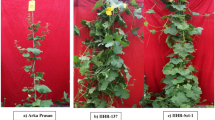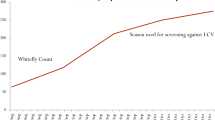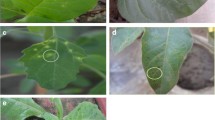Abstract
Sponge gourd is a popular vegetable grown throughout India. Tomato leaf curl New Delhi virus, the causal virus of tomato leaf curl disease, has recently been reported to be associated with sponge gourd, causing up to 100% crop loss under epidemic conditions. We have collected 30 genotypically diverse genotypes of sponge gourd from different parts of India, screened these for resistance under natural epiphytotic conditions, and then confirmed the results through challenge inoculation with a purified strain of the virus under insect-proof greenhouse conditions. The minimum vulnerability index was recorded in genotype DSG-6 (3.33), followed by DSG 7 (6.0) under the challenge (whitefly-populated) inoculation conditions. Two susceptible genotypes (‘Pusa Sneha’ and NSG-1-11), both possessing desirable fruit characters, were crossed with the two most promising resistant lines (DSG-6 and DSG-7) and the disease reaction of segregating and backcross generations studied through challenge inoculation with a purified strain of virus under insect-proof greenhouse conditions. A chi-square (χ2) test of frequency distribution based on the vulnerability index of the F2 progenies of the two resistant × susceptible crosses revealed monogenic dominant Mendelian ratio 3(R):1(S) to be the best fit in all crosses. This monogenic dominant model was further confirmed by the 1(R):1(S) ratio found to be best fit for the test cross with the susceptible parent. These results reveal that resistance to Tomato leaf curl New Delhi virus associated with yellow mosaic disease of sponge gourd is controlled by a single dominant gene in the genetic background of the resistant parents (DSG-6 and DSG-7) and that these two lines can be effectively utilized for the development of high-yielding and yellow mosaic disease-resistant varieties/hybrids of sponge gourd. This is the first conclusive identification of a resistant source and the inheritance of resistance against Tomato leaf curl New Delhi virus in sponge gourd.

Similar content being viewed by others
References
Bos L (1982) Crop losses caused by viruses. Crop Prot 1:263–282
Brown RN, Bolanos HA, Myers JR, Jahn MM (2003) Inheritance of resistance to four cucurbit viruses in Cucurbita moschata. Euphytica 129:253–258
Gilbert RZ, Kyle MM, Munger HM, Gray SM (1994) Inheritance of resistance to watermelon mosaic virus in Cucumis melo L. HortScience 9:107–110
Havey MJ (1996) CMV resistance in three sources of cucumber. Cucurbit Genet coop 19:32–33
Kempthorne O (1957) An introduction to genetic statistics. John Wiley and Sons/Chapman and Hall, New York/London
Mitra DK, Nariani TK (1965) A mosaic disease of tori (Luffa acutangula). Indian Phytopathol 18:233–236
Munshi AD, Panda B, Mandal B, Bisht IS, Rao ES, Kumar R (2008) Genetics of resistance to Cucumber mosaic virus in Cucumis sativus var. hardwickii R Alef. Euphytica 164:501–507
Panse VG, Sukhatme RV (1985) Statistical methods for agricultural workers, 4th edn. ICAR, New Delhi
Sese Lopez AI, Guillamon Gomez ML (2000) Resistance to cucurbit yellowing stunting disorder virus (CYSDV) in Cucumis melo L. HortScience 35:110–113
Silbernagel MJ, Jafari AM (1974) Temperature effects on curly top resistance in Phaseolus vulgaris. Phytopathology 64:825–827
Singh RP, Mohan J, Singh DP (2001) Symptomatology and distribution of ridgegourd mosaic virus. Agric Sci Dig 21:149–152
Sohrab SS (2005) Variability in the geminiviruses infecting cucurbits. PhD thesis. Jamia Milia Islamia, New Delhi
Sohrab SS, Mandal B, Pant RP, Varma A (2003) First report of association of Tomato leaf curl New Delhi virus with yellow mosaic disease of Luffa cylindrica in India. Plant Dis 87:1148
Soria C, Guillamon Gomez ML (1999) Resistance of Cucumis melo against Bemisia tabaci (Homoptera:Aleyrodidae). Environ Entomol 28:831–835
Swarup V (1977) Breeding procedures for cross-pollinated vegetable crops. ICAR, New Delhi
Wai T, Grumet R (1995) Inheritance of resistance to the watermelon strain of papaya ringspot virus in the cucumber line TMG-1. HortScience 30:338–340
Author information
Authors and Affiliations
Corresponding author
Rights and permissions
About this article
Cite this article
Islam, S., Munshi, A.D., Mandal, B. et al. Genetics of resistance in Luffa cylindrica Roem. against Tomato leaf curl New Delhi virus . Euphytica 174, 83–89 (2010). https://doi.org/10.1007/s10681-010-0138-7
Received:
Accepted:
Published:
Issue Date:
DOI: https://doi.org/10.1007/s10681-010-0138-7




